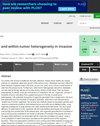StellarPath: Hierarchical-vertical multi-omics classifier synergizes stable markers and interpretable similarity networks for patient profiling
IF 4.3
2区 生物学
引用次数: 0
Abstract
The Patient Similarity Network paradigm implies modeling the similarity between patients based on specific data. The similarity can summarize patients’ relationships from high-dimensional data, such as biological omics. The end PSN can undergo un/supervised learning tasks while being strongly interpretable, tailored for precision medicine, and ready to be analyzed with graph-theory methods. However, these benefits are not guaranteed and depend on the granularity of the summarized data, the clarity of the similarity measure, the complexity of the network’s topology, and the implemented methods for analysis. To date, no patient classifier fully leverages the paradigm’s inherent benefits. PSNs remain complex, unexploited, and meaningless. We present StellarPath, a hierarchical-vertical patient classifier that leverages pathway analysis and patient similarity concepts to find meaningful features for both classes and individuals. StellarPath processes omics data, hierarchically integrates them into pathways, and uses a novel similarity to measure how patients’ pathway activity is alike. It selects biologically relevant molecules, pathways, and networks, considering molecule stability and topology. A graph convolutional neural network then predicts unknown patients based on known cases. StellarPath excels in classification performances and computational resources across sixteen datasets. It demonstrates proficiency in inferring the class of new patients described in external independent studies, following its initial training and testing phases on a local dataset. It advances the PSN paradigm and provides new markers, insights, and tools for in-depth patient profiling.StellarPath:层次-垂直多组学分类器协同稳定标记物和可解释的相似性网络,用于患者特征分析
患者相似性网络范式意味着根据特定数据对患者之间的相似性进行建模。这种相似性可以从生物组学等高维数据中总结出患者之间的关系。最终的患者相似性网络可以完成非监督/监督学习任务,同时具有很强的可解释性,适合精准医疗,并可随时使用图论方法进行分析。然而,这些优势并不能保证,它们取决于汇总数据的粒度、相似性度量的清晰度、网络拓扑结构的复杂性以及实施的分析方法。迄今为止,还没有一种病人分类器能充分利用这种模式的固有优势。PSN仍然是复杂的、未开发的和无意义的。我们介绍的 StellarPath 是一种分层垂直患者分类器,它利用路径分析和患者相似性概念,为类别和个体寻找有意义的特征。StellarPath 处理全息数据,将其分层整合到通路中,并使用新颖的相似性来衡量患者通路活动的相似性。它在考虑分子稳定性和拓扑结构的基础上,选择与生物相关的分子、通路和网络。然后,图卷积神经网络会根据已知病例预测未知患者。StellarPath 在 16 个数据集的分类性能和计算资源方面表现出色。在本地数据集的初始训练和测试阶段之后,它能熟练推断外部独立研究中描述的新患者类别。它推动了 PSN 模式的发展,并为深入的患者特征分析提供了新的标记、见解和工具。
本文章由计算机程序翻译,如有差异,请以英文原文为准。
求助全文
约1分钟内获得全文
求助全文
来源期刊

PLoS Computational Biology
生物-生化研究方法
CiteScore
7.10
自引率
4.70%
发文量
820
期刊介绍:
PLOS Computational Biology features works of exceptional significance that further our understanding of living systems at all scales—from molecules and cells, to patient populations and ecosystems—through the application of computational methods. Readers include life and computational scientists, who can take the important findings presented here to the next level of discovery.
Research articles must be declared as belonging to a relevant section. More information about the sections can be found in the submission guidelines.
Research articles should model aspects of biological systems, demonstrate both methodological and scientific novelty, and provide profound new biological insights.
Generally, reliability and significance of biological discovery through computation should be validated and enriched by experimental studies. Inclusion of experimental validation is not required for publication, but should be referenced where possible. Inclusion of experimental validation of a modest biological discovery through computation does not render a manuscript suitable for PLOS Computational Biology.
Research articles specifically designated as Methods papers should describe outstanding methods of exceptional importance that have been shown, or have the promise to provide new biological insights. The method must already be widely adopted, or have the promise of wide adoption by a broad community of users. Enhancements to existing published methods will only be considered if those enhancements bring exceptional new capabilities.
 求助内容:
求助内容: 应助结果提醒方式:
应助结果提醒方式:


